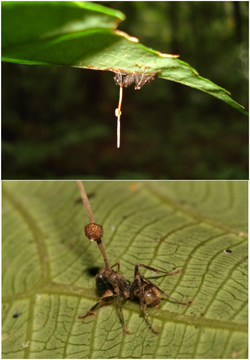| Ophiocordyceps | |
|---|---|
 | |
| Dead ants infected with Ophiocordyceps unilateralis | |
| Scientific classification | |
| Kingdom: | Fungi |
| Division: | Ascomycota |
| Class: | Sordariomycetes |
| Order: | Hypocreales |
| Family: | Ophiocordycipitaceae |
| Genus: | Ophiocordyceps Petch (1931) |
| Type species | |
| Ophiocordyceps blattae (Petch) Petch (1931) | |
| Synonyms [1] | |
List
| |
Ophiocordyceps is a genus of fungi within the family Ophiocordycipitaceae. [2] The widespread genus, first described scientifically by British mycologist Tom Petch in 1931, [3] contains about 140 species that grow on insects. [4] Anamorphic genera that correspond with Ophiocordyceps species are Hirsutella , Hymenostilbe , Isaria , Paraisaria , and Syngliocladium . [5]
Contents
- Sources and uses
- Non-insect hosts
- Species
- Phylogeny
- In popular culture
- See also
- References
- External links
One species complex, Ophiocordyceps unilateralis , is known for its parasitism on ants, in which it alters the behavior of the ants in such a way as to propagate itself more effectively, killing the ant and then growing its fruiting bodies from the ant's head and releasing its spores. [6] [7] [8] [9] To accomplish this, infected ants are stripped of their instinctive fear of heights, and leaving the relative safety of their nests, climb up the nearest plant—a syndrome known as "summit disease". [10] The ant clamps its jaws around the plant in a "death grip" and following, mycelia grow from the ant's feet and stitch them to the surface of the plant. [10] The spores released from the ant carcass fall to the ground and infect other ants that come in contact with the spores so that this cycle continues. [11] Areas with high densities of ants that have this fungus growing out of them are known as graveyards. [11]
A 48-million-year-old fossil of an ant in the death-grip of Ophiocordyceps unilateralis was discovered in Germany. [12]
